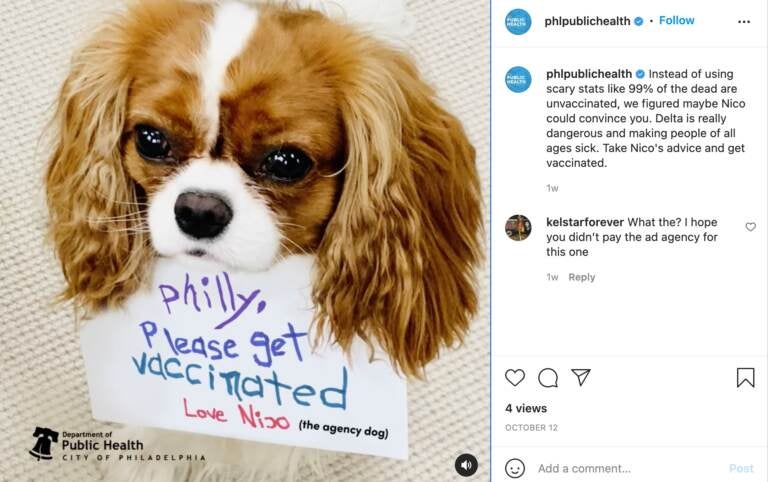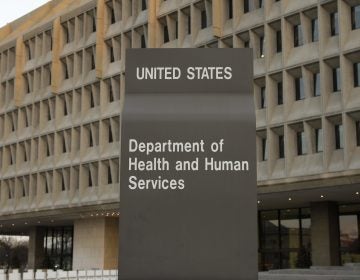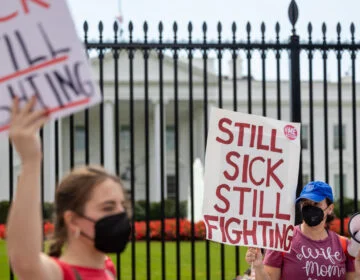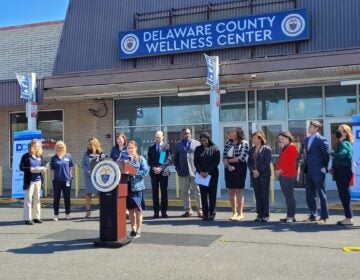Philly’s health department is getting saucy, but experts warn there could be a cost
More than 70% of Philadelphians are vaccinated, and the health department aims to reach the remaining third.

More than 70% of Philadelphians are vaccinated, and the health department aims to reach the remaining third. (Philly Public Health/Instagram)
Ask us about COVID-19: What questions do you have about the coronavirus and vaccines?
Memes make their way around the internet like a virus during flu season, and last week, the joke du jour was the red flag warning. Users on TikTok, Twitter and Instagram posted about the “warning signs” they’d watch out for in a prospective mate: “I don’t like Indian food” tweeted celebrity chef Padma Lakshmi, followed by a string of red flag emojis to convey that such a sentiment is a sign of danger.
On Twitter, Philadelphia’s Public Health Department joined in the fun. The account, which has more than 30,500 followers, posted its own version of the meme:
"I don't even know what's in it"🚩🚩🚩🚩🚩🚩🚩🚩🚩🚩🚩🚩🚩🚩🚩🚩🚩🚩🚩🚩🚩🚩🚩🚩🚩
— Philadelphia Public Health (@PHLPublicHealth) October 12, 2021
It read, “I don’t even know what’s in it,” followed by the warning flags — the implication being that someone who says that about the COVID-19 vaccine should be considered, well, dangerous.
The post garnered 600 likes and almost 300 retweets — a lot of traction for the account, whose more straightforward posts sharing vaccine availability and news articles are lucky to crack double digits.
But in the spirit of warnings, health experts caution all that attention comes at a cost. More than 70% of Philadelphians are vaccinated, and the health department aims to reach the remaining third. But researchers, doctors, and psychologists studying vaccine hesitancy all agree that jokes at the expense of the unvaccinated will only further alienate the very people the department claims it hopes to reach.
“I don’t think we can come up with any rationale that would justify using that message if your goal is to turn people’s hearts,” said Gretchen Chapman, who studies the psychology of decision-making, particularly in health care, at Carnegie Mellon University.
The tweet was met with a deluge of criticism on social media, as well as direct responses to the health department, including a concerned doctor at Penn Medicine who complained that the tweet was seen as dehumanizing among patients at their vaccination clinic.
“It took substantially longer for our primary care team to counsel unvaccinated patients on receiving a vaccine at clinic this morning after several patients cited seeing your tweet,” wrote the doctor, who did not disclose their name because they weren’t authorized to speak on behalf of the clinic. “Typically, we make progress with patients using a motivational interview technique.”
James Garrow, Communications Director at City of Philadelphia, responded by saying the tweet was a part of the department’s overall strategy to try to avoid the boring, standard risk communication used by other health departments.
“Having made more than 8,000 posts on Twitter since the start of the pandemic, we’ve learned that not every post will motivate every single person in the city, so we try different things. Sometimes we make fun of Dallas Cowboys fans, sometimes we give detailed information about vaccine availability, sometimes we idolize Beyonce, as examples,” he wrote.
But appealing to the BeyHive doesn’t exactly risk alienating a hard-to-reach population. Mocking a group who believes disinformation about the vaccine, however, might.
“If you’re being perceived as someone who doesn’t want to engage in discourse, or rejecting a whole group of people or making fun of others, that might dissuade those people from ever reading things that you’ve said,” said David N. Rapp, who studies language and decision-making at Northwestern University and has written on vaccine uptake strategies.
Getting cute to attract a younger crowd makes sense, especially when the bulk of Philadelphians who aren’t vaccinated are under the age of 45. But there is research to back the idea that reputable institutions should remain boring and bureaucratic to maintain their legitimacy.
For example, a recent study conducted by researchers from the University of Pennsylvania, alongside research institutions across the country, set out to see which kinds of text messages would work best to motivate people to get a flu shot. It found that the most successful messages were ones that reserved an appointment for a patient and rang true of the language and tone expected from a medical professional. Notably, among the least successful messages was a joke about spreading the flu, told from a dog to a cat and conveyed in picture form.
Cheeky government Twitter accounts are in vogue, from the former Pennsylvania Treasury account, to the state of New Jersey, and even an account that lieutenant governor and senate hopeful John Fetterman created for his dog.
In particular, Philly’s health department appears to be taking a page out of Baltimore’s book, which has long had a sassy and casual presence on social media. In fact, the B’more Healthy account had posted a similar version of the red flag meme just before Philly’s account did. And Baltimore’s account does more than just meme: it engages in long exchanges with anti-vaxxers on Twitter, clapping back at users who post disinformation, and making fun of them.
Gretchen Chapman is skeptical that shaming people will work. “You’re risking further alienating the non-vaccinated folks and now you’ll never be able to bring them along if you just embarrass them in public on social media,” she said.
Chapman wondered if perhaps the health department has other goals beyond just vaccinating the unvaccinated. She noted that public health agencies have taken a real hit during the pandemic in terms of their public image. Maybe the tactic is a base-rallying technique.
“Even vaccinated people think that they were inept and didn’t handle this very well,” she said. “They need to be well-run and well-funded for the next pandemic,”
To that end though, Esther Chernak of Drexel’s Dornsife School of Public Health said Philly’s Health Department is not doing itself any favors by antagonizing people if what it wants to do is build a better relationship with the community — especially after a string of recent scandals stuck the department in the national spotlight for a bungled vaccine rollout and rendered it without a permanent health commissioner for months.
“It doesn’t doesn’t contribute to trust-building, let’s just say that,” said Chernak.
Not trusting the contents of the vaccine is a common refrain, often stemming from disinformation campaigns. But Rapp said if someone is inclined to believe that, it is likely because it speaks to a broader part of their identity or personality — often centered around broader distrust in the medical system.
“Tackling that notion requires more than just tackling the idea that vaccines are good,” he said. “It requires modifying the idea that the medical community doesn’t have people’s best interests at heart.”
Twitter is not the only place where the health department is getting cheeky on social media. A video ad that ran for about two months on Facebook and Instagram begins by announcing that the health department hired an agency to convince unvaccinated Philadelphians to get vaccinated, but that they told the agency not to scare people.
So, it continued, they weren’t going to include any scary statistics about how the delta variant is surging (it’s not anymore in our region), or that 99% of recent deaths were among the unvaccinated [insert skull and cross bones]. The video ends on a frame with a cute dog holding a piece of paper in its mouth, imploring Philly to “please get vaccinated.”
The department began working with Bandujo Advertising + Design in March, and the video is just one of the ads the agency helped the department generate, said Garrow, as a part of their $1.5 million contract.
If the ad is confusing, that’s the goal, said Garrow.
“Much like when you see a commercial on TV and wonder what it was even about, sometimes public health messaging works the same way,” he said, adding that the department considered this campaign a success. He said that ad has outperformed similar ones by a margin of 150%, especially in ZIP codes with lower vaccination rates.
Rapp said he empathizes with public health departments who have been screaming the same messages from the rooftops for months, and might be inclined to try something new and experimental.
Rapp said that’s fine — as long as the departments are measuring the success of their new, cutting-edge campaigns by gathering focus groups or correlating the vaccine uptake rates in the areas where the ads were targeted.
Garrow said the city had no way of drawing a connection between the ads and corresponding vaccine rates. He did say the ad performed well in low-vaccination ZIP codes, but was unable to provide vaccination rates for those ZIP codes during the time the ad had run.
Chapman said there is a world where public health departments can be eye-catching and accessible without being dismissive.
“If you can have some of the features that make misinformation viral, but you can attach those features to your basically clear message, maybe you can get some traction,” she suggested. “Maybe that’s where we’re at at this point in the pandemic, is that Hail Marys are our best bet.”
But she made a distinction between a Hail Mary that might be novel, quirky and eye-catching, and a message that alienates a certain group — particularly a target audience.
All the experts said ultimately consistent and clear messages, not sarcasm or mockery, are key to getting people to change their behavior, even if sometimes, it might be kind of boring.

Get daily updates from WHYY News!
WHYY is your source for fact-based, in-depth journalism and information. As a nonprofit organization, we rely on financial support from readers like you. Please give today.




![CoronavirusPandemic_1024x512[1]](https://whyy.org/wp-content/uploads/2020/03/CoronavirusPandemic_1024x5121-300x150.jpg)




